
Francesco Borromini, byname of Francesco Castelli, was an Italian architect born in the modern Swiss canton of Ticino who, with his contemporaries Gian Lorenzo Bernini and Pietro da Cortona, was a leading figure in the emergence of Roman Baroque architecture.
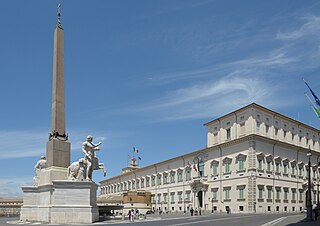
The Quirinal Palace is a historic building in Rome, Italy, one of the three current official residences of the President of the Italian Republic, together with Villa Rosebery in Naples and the Tenuta di Castelporziano, an estate on the outskirts of Rome, some 25 km from the centre of the city. It is located on the Quirinal Hill, the highest of the seven hills of Rome in an area colloquially called Monte Cavallo. It has served as the residence for thirty Popes, four Kings of Italy and twelve Presidents of the Italian Republic.
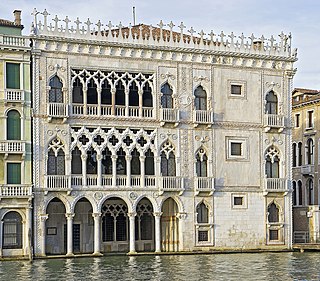
The Ca' d'Oro or Palazzo Santa Sofia is a palace on the Grand Canal in Venice, northern Italy. One of the older palaces in the city, its name means "golden house" due to the gilt and polychrome external decorations which once adorned its walls. Since 1927, it has been used as a museum, as the Galleria Giorgio Franchetti.
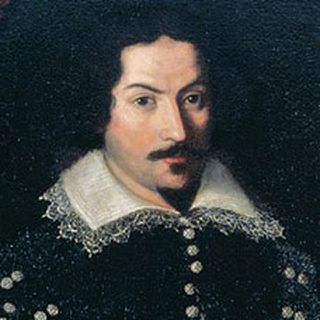
Carlo Maderno (Maderna) was an Italian architect, born in today's Ticino, who is remembered as one of the fathers of Baroque architecture. His façades of Santa Susanna, St. Peter's Basilica and Sant'Andrea della Valle were of key importance in the evolution of the Italian Baroque. He is often referred to as the brother of sculptor Stefano Maderno, but this is not universally agreed upon.

Palazzo Borghese is a palace in Rome, Italy, the main seat of the Borghese family. It was nicknamed il Cembalo due to its unusual trapezoidal groundplan; its narrowest facade faces the River Tiber. The entrance at the opposite end of the building, the "keyboard" of the cembalo, faces onto the Fontanella di Borghese, with another in a great flanking facade to the Piazza Borghese that is extended by a slightly angled facade leading down Via Borghese towards the river. Both these entrances lead into a large courtyard on one side of which is a two level open arcade, with paired Doric and Ionic columns, that frames the garden beyond.

Palazzo Barbaran da Porto is a palazzo in Vicenza, Italy designed in 1569 and built between 1570 and 1575 by Italian Renaissance architect Andrea Palladio.

Palazzo Schio is a patrician palace of the 16th century in Vicenza, northern Italy, whose facade was designed by the Italian Renaissance architect Andrea Palladio in 1560.
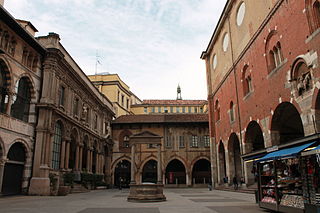
Piazza Mercanti is a central city square of Milan, Italy. It is located between Piazza del Duomo, which marks the centre of the modern city of Milan, and Piazza Cordusio, and it used to be the heart of the city in the Middle Ages. At the time, the square was larger than it is now and known as "Piazza del Broletto", after the "Broletto Nuovo", the palace that occupied the centre of the square. In the 13th century, there were six entry points to the square, each associated to a specific trade, from sword blacksmiths to hat makers.

Piazza d'Aracoeli is a square of Rome (Italy), placed at the base of the Capitoline Hill, in the Rione X Campitelli.

The Palazzo Orsini di Gravina is a Renaissance-style palace on number 3 Via Monteoliveto, in the San Lorenzo quarter of Rione San Giuseppe-Carità, of central Naples, Italy. Since 1940, it has housed the Faculty of Architecture of the University of Naples. It is located across the street and a few doors north of the sleek and modern Palazzo delle Poste. Across the street at the north end of the palace, is the Piazza Monteoliveto with its Fountain and the church of Sant'Anna dei Lombardi.
The Palazzo Costa is a Baroque style palace located on Via Roma #80 in Piacenza, Region of Emilia Romagna, Italy. The Museo Ambientale displaying period art and artifacts is now hosted by part of the palace.

Palazzo dei Convertendi is a reconstructed Renaissance palace in Rome. It originally faced the Piazza Scossacavalli, but was demolished and rebuilt along the north side of Via della Conciliazione, the wide avenue constructed between 1936 and 1950, which links St Peter's Basilica and the Vatican City to the centre of Rome. The palace is famous as the last home of the painter Raphael, who died there in 1520.
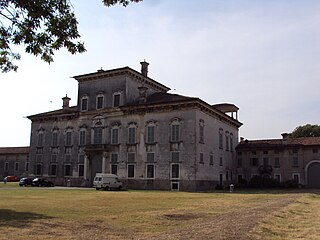
The Palazzo Lechi, or more aptly also called Villa di Conti Lechi, is a rural palace located on via del Palazzo 60 in Montirone, Province of Brescia, region of Lombardy, Italy.

Palazzo Nasciaro is an 18th-century townhouse in Naxxar, Malta, built during the Order of St. John. The townhouse was originally built as a family home, but has undergone adaptive reuse several times to fit the changing needs of the local population.

Palazzo Giustiniani or the Piccolo Colle is a palace on the Via della Dogana Vecchia and Piazza della Rotonda, in Sant'Eustachio, Rome.

Palazzo De Ballis is a 15th-century historical building of Spanish Gothic architecture; the Tower De Ballis is a part of it. It is located in the town centre of Alcamo, in the province of Trapani.

The Palazzo del Giardino or Palazzo Ducale del Giardino is a historic palace in the Parco Ducale in Parma. It is not to be confused with the official Parma residence of Marie Louise, Duchess of Parma between Palazzo della Pilotta and Palazzo della Provincia in what is now known as piazzale della Pace - she also lived at the Ducal Palace of Colorno and in the Casino dei Boschi in Sala Baganza. The main Ducal Palace in Parma, the Palazzo della Pilotta and the teatro Reinach were all destroyed in bombing on 13 May 1944.

The Palazzo Paternò del Toscano, also known as the Palazzo del Toscano, is an notable palace in Piazza Stesicoro, in the center of Catania, region of Sicily, southern Italy. The building now houses many shops, but is also used by schools, and for cultural programs. The white stone facade stands before the Monument to Vincenzo Bellini and rises in contrast to the palace across via Aetna, the white and black Palazzo Tezzano.
The Palazzo Filangeri-Cutò is a Baroque-style aristocratic palace located on via Maqueda 26 in the ancient quarter of Albergheria of central Palermo, region of Sicily, Italy. Once the urban palace of a wealthy and prominent family, since the 19th-century the palace has been subdivided into numerous apartments and businesses, and in dire need of restoration.

The Palazzo Celestri di Santacroce, also known as the Palazzo Sant'Elia is a Baroque-style aristocratic palace located on via Maqueda 90 in the ancient quarter of Kalsa of central Palermo, region of Sicily, Italy. Once the urban palace of a wealthy and prominent family, a large portion of the palace is now used for exhibitions and private functions. The palace is diagonal to the Southeast of the Palazzo Comitini, and just a block north of the church of the Assunta.



















